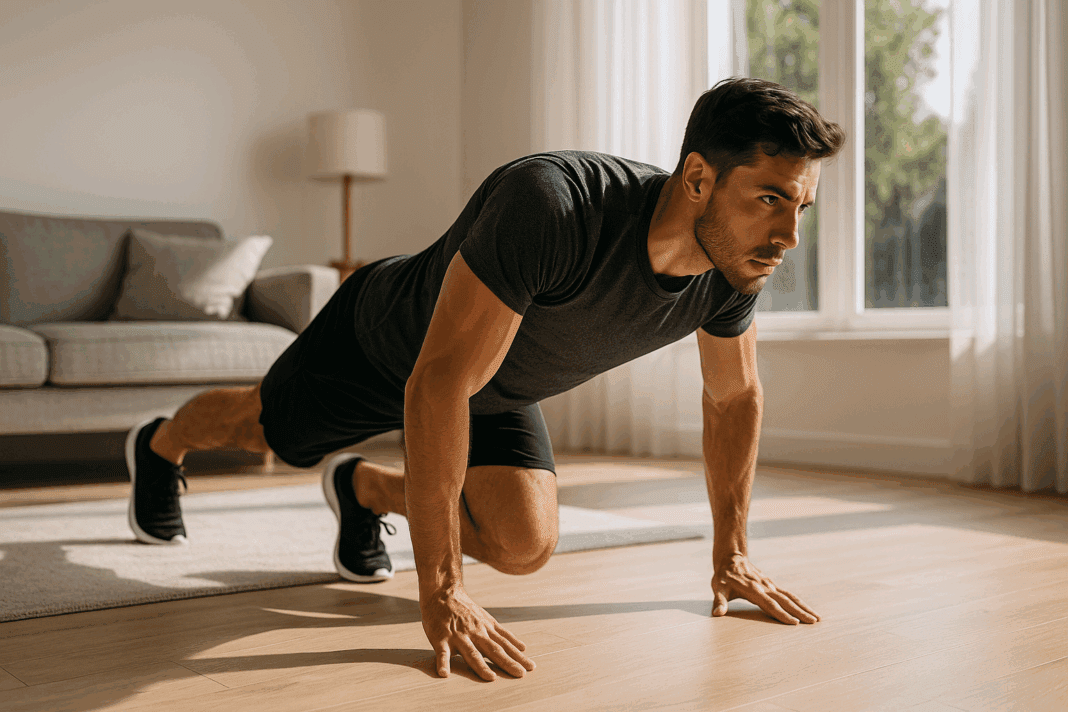Introduction: Why Full Body, No Equipment Training is the Key to Functional Strength
In the pursuit of fitness, many men often fall into the trap of overcomplicating their training—believing that progress depends on costly gym memberships or fancy equipment. Yet the most transformative and enduring gains in strength and muscle often emerge from the simplest foundations. A full body no equipment workout men can follow consistently is not only convenient and accessible but also profoundly effective when rooted in scientific principles and executed with discipline. This training style taps into primal movement patterns, engages multiple muscle groups simultaneously, and demands full-body coordination, making it ideal for those seeking strength, mobility, and muscle development without the need for external weights.
Modern exercise physiology confirms that muscular growth and strength adaptations are the result of three primary factors: mechanical tension, metabolic stress, and muscle damage. These can be achieved through intelligently designed bodyweight routines that manipulate tempo, range of motion, and exercise complexity. When programmed properly, a full body no equipment workout men can perform at home or on the go rivals, and in many ways surpasses, traditional gym-based routines in terms of efficiency and functional benefits. This article explores how to build muscle and cultivate powerful strength through a bodyweight approach tailored specifically for men—without a single dumbbell, barbell, or resistance band in sight.
You may also like: The Ultimate Bodyweight Strength Program to Build Muscle Without Weights
The Science of Muscle Growth Without Equipment
The idea that building muscle requires heavy resistance training is deeply ingrained in popular fitness culture, but it doesn’t tell the full story. Resistance is only one method of providing the mechanical tension necessary to stimulate muscle adaptation. In reality, your body doesn’t distinguish between resistance from weights and resistance created by your own mass—it simply responds to the demand placed on it. As long as muscle fibers are recruited and fatigued sufficiently, growth can occur.
Bodyweight training excels at enhancing time under tension, which increases metabolic stress and encourages hypertrophy. Slow eccentrics—lowering a movement with control—extend this tension, while high-repetition sets generate metabolic fatigue that leads to cellular swelling and anabolic signaling. Additionally, by focusing on compound, multi-joint exercises, men can activate large muscle groups simultaneously, triggering hormonal responses that support whole-body growth. Movements such as push-ups, squats, lunges, and planks don’t just build muscle—they challenge coordination, endurance, and proprioception in ways that weights often do not.
Furthermore, by progressing to single-limb variations or unstable movement patterns, men can apply progressive overload without changing the weight. This is particularly relevant for men training at home or without equipment. By combining high volume, strict control, and precise form, bodyweight training enables continuous improvement without the limitations of external tools. The best bodyweight exercises for men no equipment required are those that scale in difficulty and engage the body’s full kinetic chain.
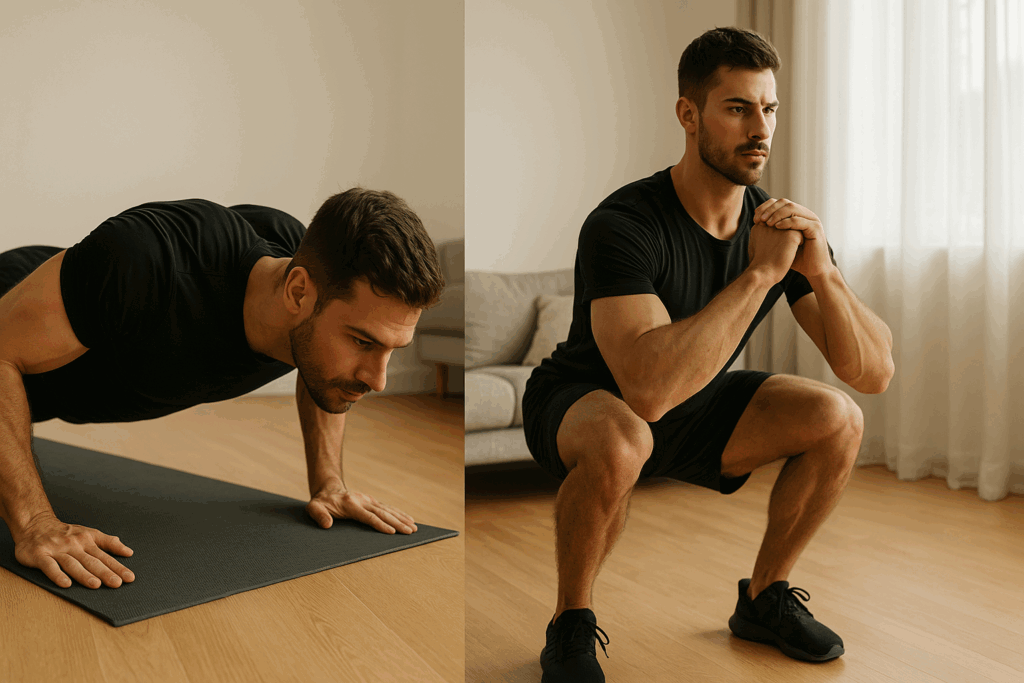
The Fundamentals of Effective Full Body Training
To maximize results from a no-equipment regimen, it’s important to embrace a few key principles that underlie every successful training plan. First, every full-body session should target the five essential movement patterns: push, pull, squat, hinge, and core stabilization. While some of these, like pulling, may require creativity in the absence of traditional gym tools, using body positioning and environmental adaptations (such as table rows or doorframe holds) can replicate these movements effectively.
Next is intensity and structure. A well-designed full body no equipment workout men can follow should include circuits or supersets that keep rest short and heart rate elevated. This approach burns fat while building muscle, and it promotes both anaerobic and aerobic conditioning. Sessions should be planned to allow a balance of upper body, lower body, and core engagement across different angles and planes of motion.
Another foundational concept is progression. Just as you would add plates to a barbell, bodyweight training must evolve in difficulty. This can be done by increasing repetitions, slowing the tempo, decreasing rest, or transitioning to harder versions of the same movement (e.g., push-ups to archer push-ups to pseudo-planche push-ups). The integration of mobility and flexibility work within the training plan also ensures injury prevention and optimizes joint health, allowing consistent training without setbacks.
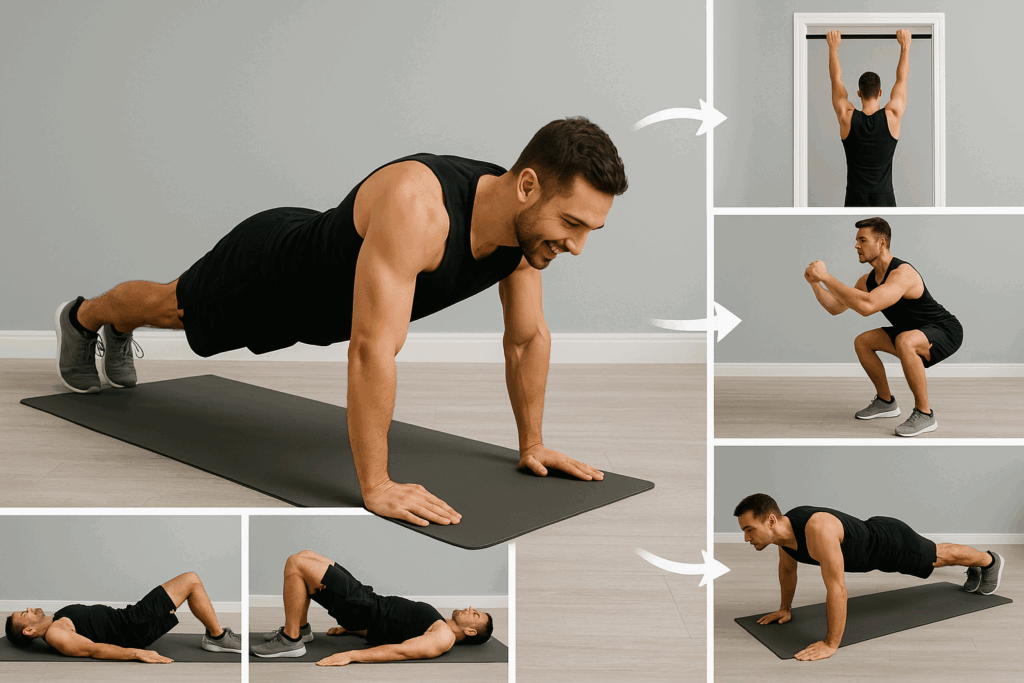
Best Bodyweight Exercises for Men No Equipment Required
Not all bodyweight exercises are created equal. The best bodyweight exercises for men no equipment needed are those that provide maximal muscle recruitment, require minimal setup, and offer scalable difficulty. These movements create full-body tension, challenge coordination, and translate to real-world functionality.
Push-ups remain a cornerstone. They target the chest, shoulders, triceps, and core, and their variations—from wide-grip to diamond to explosive clapping push-ups—allow for targeted muscle emphasis. Squats and their unilateral counterparts, like Bulgarian split squats and pistol squats, build powerful legs and improve balance. Lunges introduce dynamic instability that challenges glutes, quads, and calves while reinforcing core control.
Pull-based exercises are often neglected in bodyweight routines due to equipment limitations, but creative solutions abound. Inverted rows under a sturdy table, towel rows with a closed door, or isometric doorframe pulls effectively target the lats, rhomboids, and biceps. For core work, planks, leg raises, hollow holds, and mountain climbers provide dynamic and static tension that enhances stability and posture. Each of these movements, when layered into a cohesive plan, supports the strength and symmetry required for long-term muscular development.
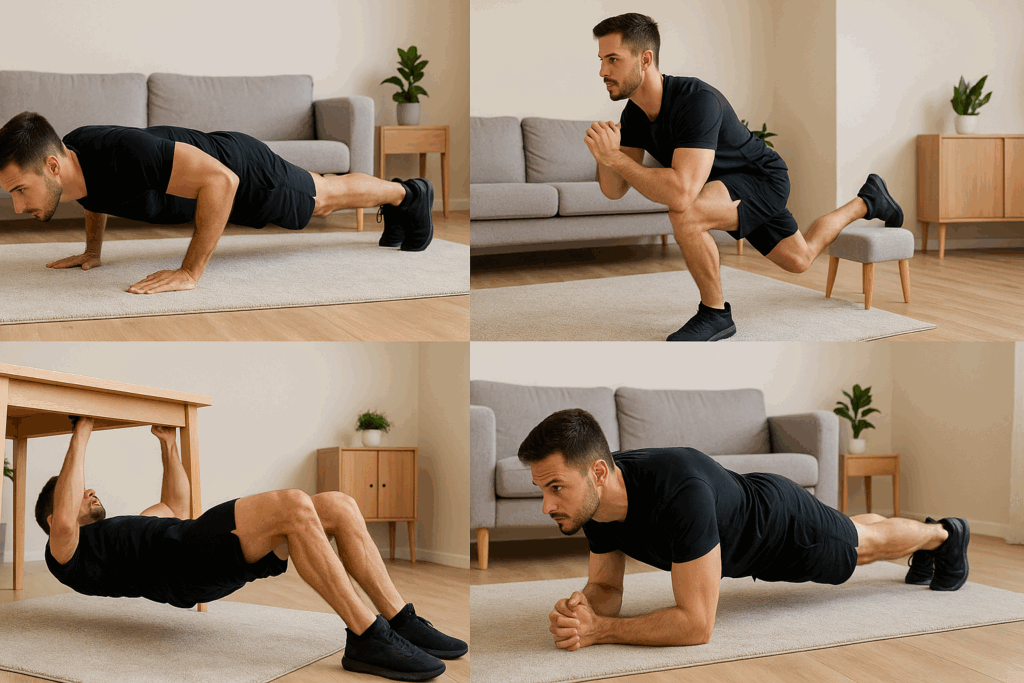
Designing a Full Body No Equipment Workout Men Can Follow Anywhere
A successful no-equipment workout is built on thoughtful programming and consistent execution. When constructing a routine, it’s essential to create a balance of movement types across push, pull, lower body, and core categories. Begin with a dynamic warm-up that includes arm circles, leg swings, and high knees to prepare the joints and elevate heart rate. Follow this with 30–45 minutes of compound bodyweight training using supersets or circuits to maintain intensity and time efficiency.
For example, a typical session might alternate between upper and lower body movements, such as push-ups, squats, towel rows, and walking lunges. A second circuit could include explosive exercises like jump squats and plyo push-ups, along with core stabilization through planks and reverse crunches. Three rounds of each circuit with minimal rest create metabolic stress and promote hypertrophy while challenging the cardiovascular system. Cool-downs should include static stretching and breathwork to accelerate recovery.
Men aiming for muscle gain should train three to five days per week, ensuring at least one rest or active recovery day. Over time, the workout can evolve by reducing rest intervals, increasing reps, or transitioning to more complex movements. By documenting progress, such as improved form, increased reps, or added variations, trainees build motivation and track long-term adaptation. Ultimately, the best bodyweight exercises for men no equipment needed can serve as the backbone of a lifelong fitness journey when they are integrated with precision, purpose, and progression.
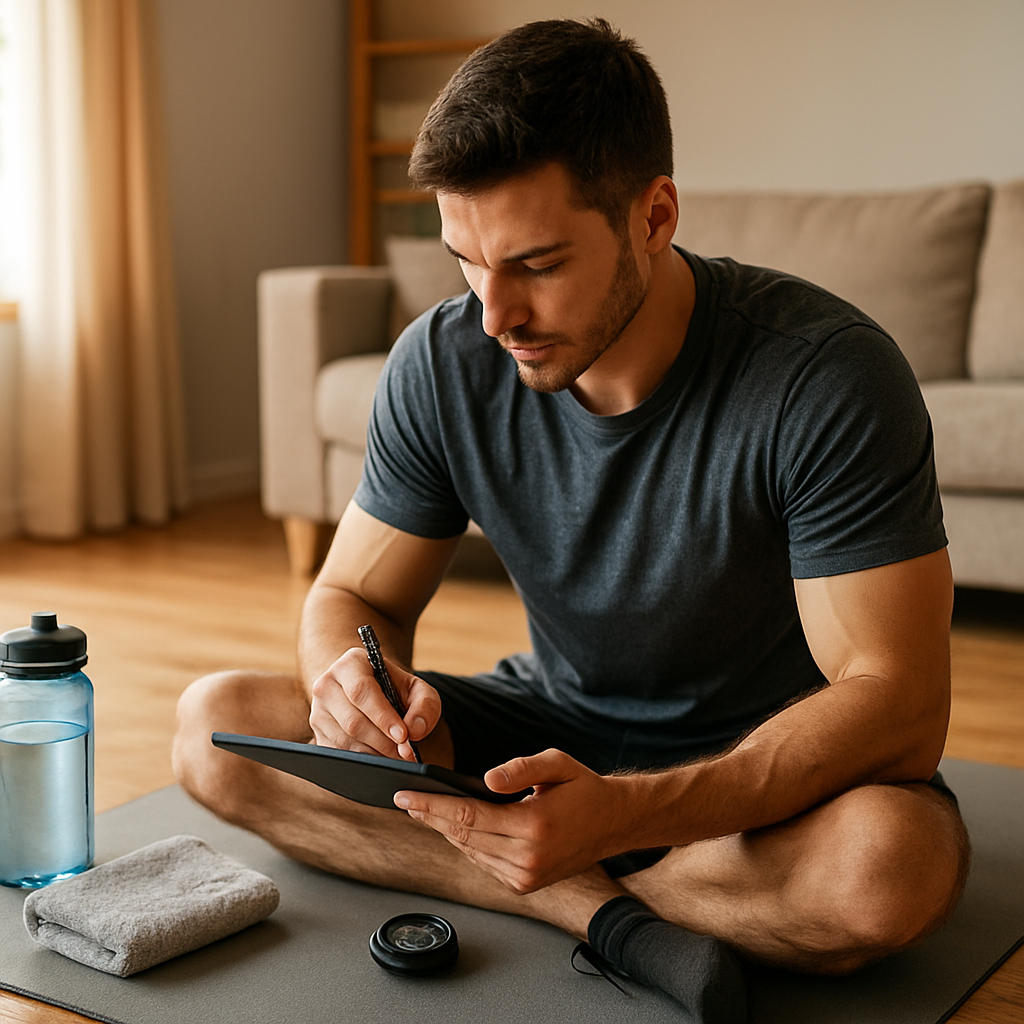
Why the Full Body No Equipment Workout Men Rely on Supports Holistic Fitness
The appeal of full-body, no-equipment training extends beyond aesthetics. These workouts build a foundation of athleticism that improves real-world performance. Whether it’s lifting groceries, climbing stairs, or sprinting to catch a train, the functional strength developed through bodyweight training enhances movement quality and efficiency. This style of training encourages joint resilience, tendon strength, and dynamic control—key aspects often overlooked in traditional bodybuilding programs.
Additionally, a full body no equipment workout men commit to develops mental discipline and proprioceptive awareness. Mastering body control through progressively difficult exercises fosters a connection between mind and muscle that’s critical for maximizing output and preventing injury. Unlike gym machines that isolate and support, bodyweight movements demand intrinsic stability and self-regulation.
Another significant benefit is accessibility. With no need for equipment, anyone can train in their living room, a park, or even a hotel room while traveling. This adaptability eliminates common excuses related to time, location, or resources. By reducing friction to entry, this training format fosters consistency—the most vital factor in achieving long-term fitness results.

Maximizing Results with the Best Bodyweight Exercises for Men No Equipment Required
To get the most out of your training, it’s important to strategically rotate through the best bodyweight exercises for men no equipment required. This keeps muscles guessing and prevents stagnation. Integrating skill-based movements like wall-supported handstands or L-sits adds an element of neurological complexity, which sharpens balance and muscular coordination.
It’s also important to vary tempo and repetition schemes. Slowing down the eccentric phase of a push-up or squat increases time under tension and enhances muscle activation. High-rep burnout sets, on the other hand, build muscular endurance and metabolic resilience. By strategically alternating these formats across your workout week, you stimulate different muscle fibers and energy systems.
Rest and recovery play an equally vital role. Full body no equipment workout men perform at high intensity should be followed by quality sleep, nutrient-dense meals, and regular mobility work. Fascia release techniques using foam rollers or simple stretching routines can significantly enhance recovery and reduce delayed onset muscle soreness. By viewing training as a holistic practice that encompasses movement, nutrition, and recovery, men maximize gains and reduce risk of burnout.
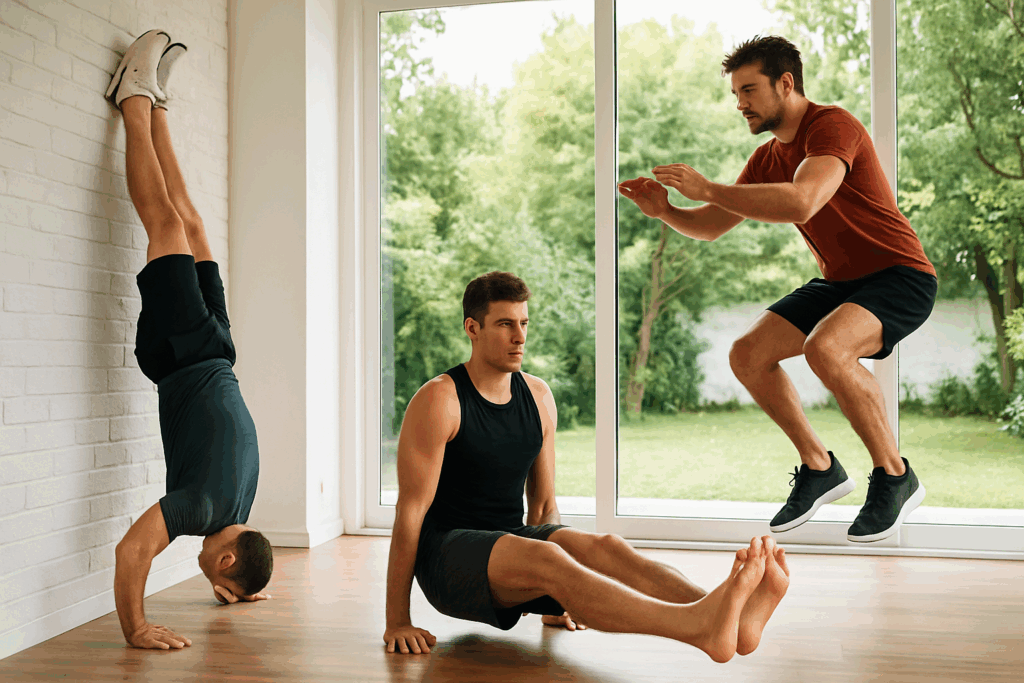
Progressive Overload Without Equipment: Turning Bodyweight into a Weapon
While traditional gym-goers equate strength gains with lifting heavier weights, progressive overload in bodyweight training hinges on increasing complexity, volume, and control. Instead of adding a plate, try elevating your feet during push-ups, extending the lever arm during planks, or holding an isometric position longer than before. These small changes magnify resistance and force muscles to adapt.
Unilateral training is another potent tool. Performing pistol squats, single-leg hip thrusts, or one-arm push-ups challenges balance and recruits stabilizer muscles far more than bilateral movements. Asymmetry in strength or control becomes immediately evident—and correctable—when you isolate one side of the body. This improves muscular symmetry and guards against imbalances that can lead to injury.
Tracking performance using a journal or digital app can help maintain progressive overload over time. Noting changes in tempo, reps, perceived exertion, and movement mastery allows you to structure future workouts intelligently. With this data, each session builds on the last, forming a cycle of continuous improvement that compounds into lasting results.
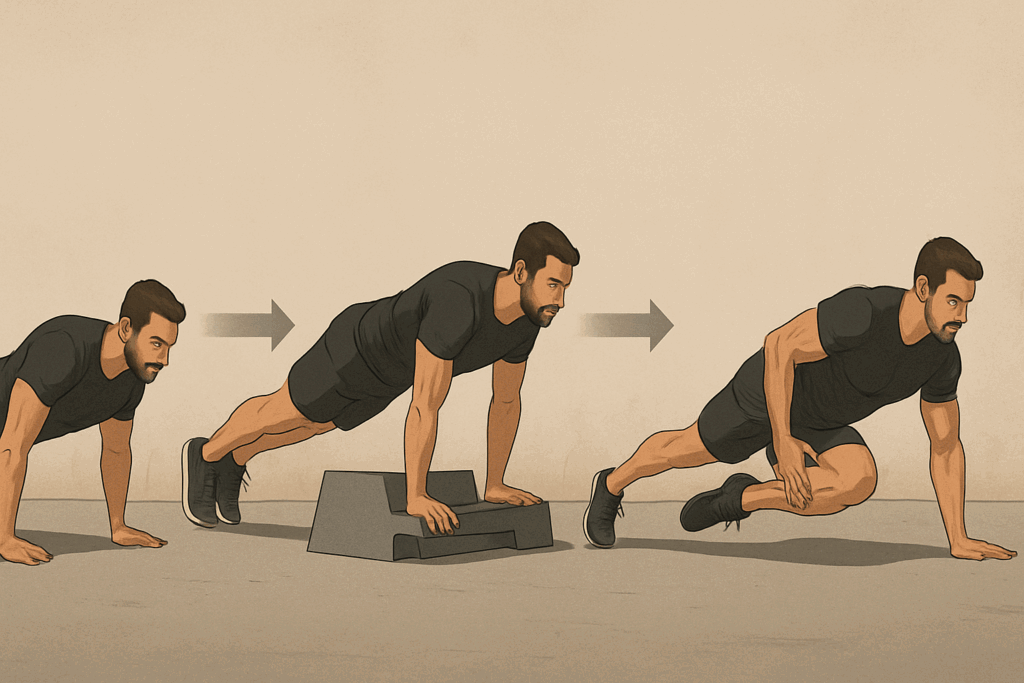
Frequently Asked Questions: Mastering the Full Body No Equipment Workout Men Rely On
1. How does a full body no equipment workout men follow compare to traditional weightlifting?
While traditional weightlifting focuses on isolated muscle groups using external loads, a full body no equipment workout men perform emphasizes functional strength, core stability, and muscular coordination. Unlike machines that guide your movement, bodyweight workouts require self-regulation, activating stabilizer muscles that often go unused in the gym. Over time, this approach can improve joint resilience and movement efficiency. Additionally, because bodyweight exercises engage multiple muscle groups simultaneously, they promote better hormonal responses and metabolic efficiency. The result is not only strength and size but also improved balance, endurance, and injury prevention.
2. What are some advanced variations of the best bodyweight exercises for men no equipment needed?
For those looking to intensify their routine, advanced bodyweight variations include one-arm push-ups, pseudo planche push-ups, pistol squats, L-sits, and wall-supported handstands. These moves challenge balance, proprioception, and control—qualities often underdeveloped in machine-based training. Progressions might involve increasing time under tension or combining movements into complex sequences, such as a push-up-to-pike or pistol squat with a jump. These variations not only develop more muscle but also engage the central nervous system more deeply. Regular inclusion of these exercises encourages continuous adaptation, keeping the workouts fresh and progressive.
3. How can I assess progress with a full body no equipment workout men use at home?
Tracking bodyweight progress requires a combination of qualitative and quantitative indicators. Increase in reps, extended time under tension, and smoother execution of difficult movements are strong signs of improvement. Visual changes such as muscle definition and posture alignment also reflect progress. Journaling metrics like rest time, perceived exertion, or the ability to hold isometric positions longer provides objective feedback. Including periodic fitness tests—such as maximum push-ups in 60 seconds or a plank hold challenge—adds structure to your tracking method.
4. Is there a specific age range that benefits most from the best bodyweight exercises for men no equipment?
The beauty of the best bodyweight exercises for men no equipment is that they are adaptable across all ages and fitness levels. Young men can build foundational strength and coordination, while older adults benefit from joint-friendly movement patterns that support longevity and independence. Movements like bodyweight squats, planks, and rows offer safe and scalable intensity. For older men, these routines can also serve as functional rehab or mobility enhancement. As long as the exercises are adjusted to one’s capacity, the benefits apply universally.
5. How does nutrition support gains from a full body no equipment workout men stick with?
Muscle growth from bodyweight training relies heavily on nutritional support, especially when training volume is high. Adequate protein intake—approximately 1.6 to 2.2 grams per kilogram of body weight—is essential for muscle protein synthesis. Additionally, complex carbohydrates provide sustained energy, while healthy fats support hormonal balance and joint health. Hydration and micronutrient intake—particularly magnesium, zinc, and vitamin D—also influence recovery and performance. Consistent training paired with balanced nutrition ensures that the strength developed from full body no equipment workouts isn’t compromised.
6. Can the best bodyweight exercises for men no equipment replace gym machines permanently?
In many cases, yes—especially for men prioritizing mobility, convenience, and functional fitness. The best bodyweight exercises for men no equipment required train the same muscle groups as gym machines but with added benefits like core activation and balance training. While machines allow for isolated hypertrophy, bodyweight exercises develop a more integrated strength system. Additionally, bodyweight training often leads to greater muscle endurance, injury resilience, and environmental versatility. For most functional and aesthetic goals, bodyweight routines are not only sufficient—they’re ideal.
7. What role does flexibility and mobility play in full body no equipment workout men programs?
Flexibility and mobility are foundational to effective bodyweight training. Without sufficient mobility, range of motion in movements like squats or push-ups becomes restricted, diminishing muscle recruitment and increasing injury risk. A well-rounded program includes dynamic stretches before and static stretches after training. Exercises like the world’s greatest stretch, deep squats, or cat-cow flows restore tissue elasticity and joint function. Long term, improved mobility enhances movement quality, allowing for more advanced bodyweight exercise variations.
8. How can full body no equipment workout men routines improve cardiovascular health?
Bodyweight training, especially when structured as high-intensity circuits or supersets, significantly elevates heart rate and oxygen consumption. Exercises like jump squats, burpees, and mountain climbers not only build muscle but also boost cardiovascular endurance. Unlike steady-state cardio, these workouts stimulate both aerobic and anaerobic systems, improving heart rate variability and VO2 max. Men looking to combine muscle growth with fat loss find this approach especially effective. The convenience of combining cardio and strength in one session makes these routines time-efficient and heart-healthy.
9. What mindset shifts are necessary to stay motivated without equipment?
Training without equipment demands a shift in perception—from chasing external load numbers to mastering internal control. Success comes from embracing form precision, consistency, and progression rather than simply adding weight. Celebrating small victories—like holding a plank longer or finally nailing a pistol squat—fosters intrinsic motivation. Creating challenges, gamifying reps, or joining virtual communities also supports accountability. Over time, men often find the simplicity and self-reliance of bodyweight training to be empowering.
10. How can I build a long-term plan using the full body no equipment workout men framework?
A sustainable bodyweight training plan includes cycles of intensity, recovery, and skill acquisition. Begin with foundational phases that establish proper movement mechanics. Progress into hypertrophy phases emphasizing volume and time under tension. Incorporate skill development blocks focused on mastering advanced variations or isometric holds. Regular deload weeks, mobility sessions, and mental resets should also be scheduled. By periodizing your routine, a full body no equipment workout men program can evolve for years without burnout or stagnation.

Conclusion: Why Full Body No Equipment Workout Men Commit To Delivers Sustainable Strength
In a landscape dominated by gym trends and shiny equipment, the enduring power of bodyweight training remains a beacon of simplicity and effectiveness. A well-structured full body no equipment workout men can sustain over time not only delivers hypertrophy and strength—it also supports mental focus, agility, and injury resilience. By drawing on timeless movement patterns and leveraging the body’s own resistance, men unlock a comprehensive fitness approach adaptable to any phase of life.
The best bodyweight exercises for men no equipment necessary serve as building blocks for a lifelong athletic foundation. These workouts demand nothing but effort, discipline, and consistency—traits that define real strength beyond the mirror. From beginners seeking to gain muscle without a gym to elite athletes optimizing performance with minimalist tools, the bodyweight approach scales seamlessly to meet any goal.
Ultimately, the full body no equipment workout men rely on offers more than a temporary challenge—it offers a blueprint for physical mastery. It proves that with commitment and intelligent progression, equipment becomes optional, but results do not. By trusting in the process and embracing the challenge of mastering one’s own body, men can cultivate enduring muscle, power, and confidence that transcends the boundaries of gym walls.
Further Reading:
Full Body Workout Without Weights


